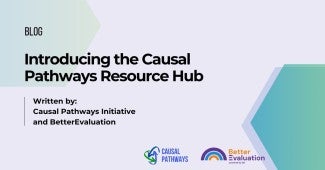Introducing the Causal Pathways Resource Hub
We are pleased to launch the Causal Pathways Resource Hub: A set of new and revised pages on BetterEvaluation, developed in partnership with the Causal Pathways Initiative.
This initiative seeks to help philanthropy and other funders open the black box of strategy and systems change by building awareness, will, and skills to use evaluation approaches that can make sense of causal relationships in complex change contexts.
The Causal Pathways Resource Hub is a set of resources, including new and updated method and approach pages, that explain why and how to explore causal pathways.
The hub gives users – from those new to evaluation to seasoned evaluators and evaluation managers – the information they need to commission or conduct evaluations that explore the evidence for pathways leading to change, confirming or challenging theories and assumptions about how change happens. The content includes guidance and information on a wide range of approaches, some of which, by their nature, explore causal pathways and others that can be applied in ways to do so.
What do we mean by a causal pathways evaluation?
A causal pathway is created by a series of events and contributing factors which lead to an outcome or impact. A causal pathways perspective on evaluation focuses on understanding how, why and under what conditions change happens, has happened, or is not happening. It does this by exploring the interconnected chains of causal links that lead to a range of outcomes and impacts.
These causal pathways are likely to involve multiple actors, contributing factors, events, and actions – not only the activities associated with the program, project or policy being evaluated or its stated objectives. A causal pathways perspective pays particular attention to equity: how and why different groups and individuals experience interventions differently and experience different outcomes as a result—something that is often invisible in evaluations that focus on measuring an average effect.
Rather than being a specific approach, causal pathways evaluation can draw on a combination of evaluation approaches, processes, and methods. It uses a range of evidence types, with a particular focus on participatory processes to engage participants as evaluation designers, data collectors, sources, analysts, and presenters of findings in evaluation processes, thus amplifying their voices and narratives.
The Causal Pathways Initiative has articulated the following features that distinguish a causal pathways evaluation perspective:
- Addressing power and inclusion
- Valuing actors’ narratives
- Articulating explicit causal pathways
- Paying attention to a range of outcomes and impacts, both positive and negative
- Understanding contextual variation
- Using an iterative, bricolage approach to evaluation design
- Drawing on a range of causal inference strategies
- Taking a complexity-appropriate approach to evaluation quality and rigour
More information on these features can be found on the thematic page Causal Pathways Perspective.
Causal Pathways Resource Hub
The Causal Pathways Resource Hub team (see list of members below) worked to create a widely accessible and useful library that could help evaluation commissioners and evaluators examine causal pathways in complex change contexts. They included approaches and methods that are either designed to or can be adapted to do the following:
- unpack and test theories of change
- examine a range of outcomes – intended and unintended
- consider contextual variation
- use a range of approaches to support causal inference
- value inclusion and empowerment.
The Causal Pathways Resource Hub team identified BetterEvaluation as a logical home for this hub, given its respected status as a global “go-to” site about all things evaluation. The team was thrilled when BetterEvaluation agreed to partner on this project.
Together, the Causal Pathways Resource Hub team and GEI’s BetterEvaluation team, with support from other Causal Pathways Initiative members, honed the description of Causal Pathways evaluation, updated and added approach and method pages, and identified key resources to include in the hub. As well as updating and expanding pages on particular evaluation approaches, this collaboration has led to a revision and expansion of material in the BetterEvaluation Rainbow Framework, which organises more than 300 methods in terms of more than 30 different tasks in evaluation.
We have revised pages relating to the quality of evaluation and developing a theory of change for an intervention. We have also developed a new task page for Develop a design for an evaluation – including methods such as iterative design, joint design, and bricolage design – and a new task page for Understanding the situation. We have also added a new method, causal mapping, which helps document and analyse the causal claims (about "what causes what") that people make in interviews, conversations and documents.
Both teams consider this a living hub that will be updated as evaluation thinking evolves and new resources become available. We would love to hear your feedback or ideas for additional content or resources.
Explore the new and updated method and approach pages, along with the new cross-cutting thematic page:
Theme page
Approaches
Methods and tasks
With thanks to:
This blog and the pages within the Causal Pathway Resource Hub were developed, revised, and reviewed by the members of the Causal Pathways Initiative and by Patricia Rogers, Kaye Stevens and Alice Macfarlan. Thanks go especially to the Causal Pathways Resource Hub Team: Carlisle Levine, Fiona Remnant, Steve Powell, Abdoul Karim Coulibaly, Hippolyt Pul and Yulianto Dewata, as well as to Causal Pathway Initiative members who provided invaluable input on the thematic page and various approach and method pages: Marina Apgar, Heather Britt and Melanie Punton, and to other members of the Causal Pathways leadership team: Julia Coffman, Jewlya Lynn and Kimberlin Butler.
